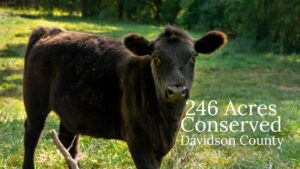
by Crystal Cockman
12/20/2016
 During a visit to the Pee Dee National Wildlife Refuge a few years ago with the Greater Uwharrie Conservation Partnership, we spotted a unique critter – the hickory horned devil. This species is among the largest caterpillars found in North America, growing up to 6 inches in length, and they have a distinctive greenish-blue appearance with body segments that are surrounded by black spines and black-tipped orange-red horns, which is why they are called the hickory horned devil.
During a visit to the Pee Dee National Wildlife Refuge a few years ago with the Greater Uwharrie Conservation Partnership, we spotted a unique critter – the hickory horned devil. This species is among the largest caterpillars found in North America, growing up to 6 inches in length, and they have a distinctive greenish-blue appearance with body segments that are surrounded by black spines and black-tipped orange-red horns, which is why they are called the hickory horned devil.
Though they look pretty ominous, they are actually harmless. Their dragon-like appearance is just meant to scare off any would-be predators. However, when they are disturbed they can throw their bodies back and forth in a ferocious display creating a buzzing sound meant to be a warning, but they have no toxicity.
Before pupation, the larva turns from green to turquoise. It borrows into the ground to pupate instead of building a cocoon. Some pupae spend two winters in the ground, believed to be an adaptation to deal with adverse environmental conditions such as fires or floods. The pupae are glossy brown in color.
In spring the adult regal moth, also known as royal walnut moth, emerges. The adult forms do not eat, but simply mate and lay eggs. They live only about a week in adult form. Females release pheromones, which can attract a male from up to a mile away. The adult moth is the largest moth by mass north of Mexico, but not by size, that goes to the Cecropia moth. The regal moth has a wingspan up to 5.5 inches. Females are larger than males. Moths are greenish-gray with orange veins and yellow spots.
Hickory horned devils live in deciduous forests in the eastern United States, from Missouri to Massachusetts and south from Texas to central Florida. Their host plants include hickories, ash, walnuts, persimmon, sweetgum, and they even utilize the non-native privet. They are more common in the Deep South, and become less common as you go northward.
As many as six species of tachinid flies, one species of sarcophagid fly, and and one species of braconid wasp are known to parasitize hickory horned devils. They attach their eggs to the larva, and then they hatch and consume the pupa.
Hickory horned devils are known to eat voraciously, particularly right before they pupate, but they are not so ravenous as to pose any real threat to their host trees. They are also food for a variety of bird and snake species, and play an important role in the ecosystem.